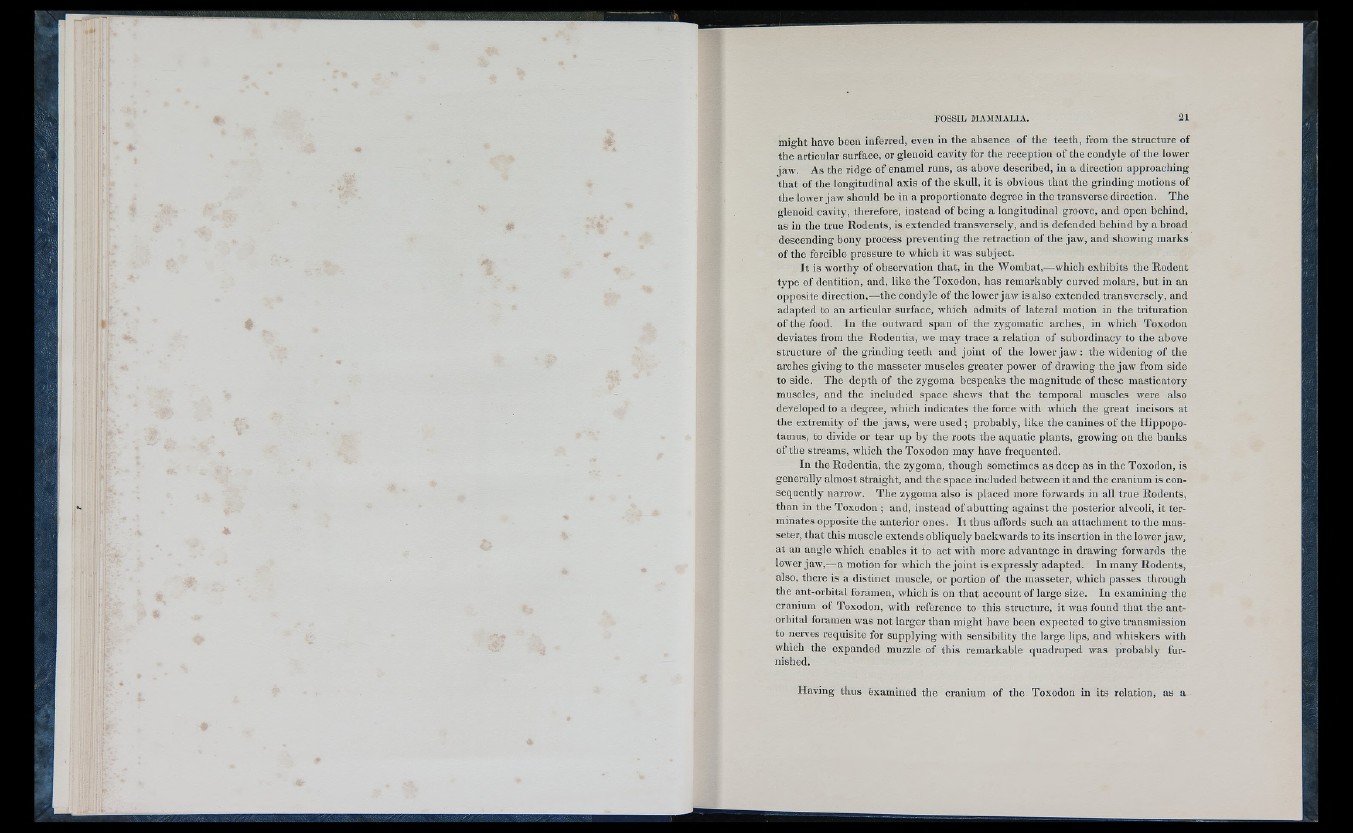
might have been inferred, even in the absence o f the teeth, from the structure o f
the articular surface, or glenoid cavity for the reception o f the condyle o f the lower
jaw. A s the ridge o f enamel runs, as above described, in a direction approaching
that of the longitudinal a x is o f the skull, it is obvious that the grinding motions o f
the lower jaw should be in a proportionate degree in the transverse direction. The
glenoid cavity, therefore, instead o f being a longitudinal groove, and open behind,
as in the true Rodents, is extended transversely, and is defended behind by abroad
descending bony process preventing the retraction o f the jaw, and showing marks
o f the forcible pressure to which it was subject.
It is worthy o f observation that, in the Wombat,— wliich exhibits the Rodent
type o f dentition, and, lik e the Toxodon, has remarkably curved molars, but in an
opposite direction,—the condyle o f the lower jaw is also extended transversely, and
adapted to an articular surface, which admits o f lateral motion in the trituration
o f the food. In the outward span o f the zygomatic arches, in which Toxodon
deviates from the Rodentia, we may trace a relation o f subordinacy to the above
structure o f the grinding teeth and jo int o f the lower jaw : the widening o f the
arches giving to the inasseter muscles greater power o f drawing the jaw from side
to side. The depth o f the zygoma bespeaks the magnitude o f these masticatory
muscles, and the included spac e shews that the temporal muscles were also
developed to a degree, which indicates the force with which the great incisors at
the extremity o f the jaws, were used ; probably, like the canines o f the Hippopotamus,
to divide or tear up by the roots the aquatic plants, growing on the banks
o f the streams, which the Toxodon may have frequented.
In the Rodentia, the zygoma, though sometimes as deep as in the Toxodon, is
generally almost straight, and the space included between it and the cranium is consequently
narrow. The zygoma also is placed more forwards in all true Rodents,
than in the Toxodon ; and, instead o f abutting against the posterior alveoli, it terminates
opposite the anterior ones. I t thus affords such an attachment to the mas-
seter, that this muscle extends obliquely backwards to its insertion in the lower jaw,
at an angle which enables it to act with more advantage in drawing forwards the
lower jaw,—a motion for which the jo int is expressly adapted. In many Rodents,
also, there is a distinct muscle, or portion of the masseter, which passes through
the ant-orbital foramen, which is on that account o f large siz e . In examining the
cranium o f Toxodon, with reference to this structure, it was found that the ant-
orbital foramen was not larger than might have been expected to give transmission
to nerves requisite for supplying with sensibility the large lips, and whiskers with
which the expanded muzzle o f this remarkable quadruped was probably furnished.
Having thus examined the cranium o f the Toxodon in its relation, as a